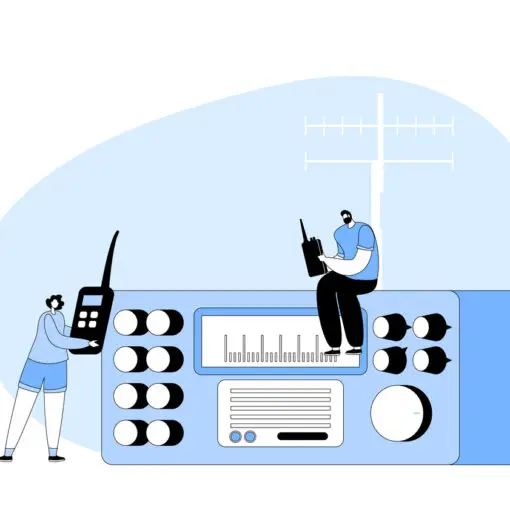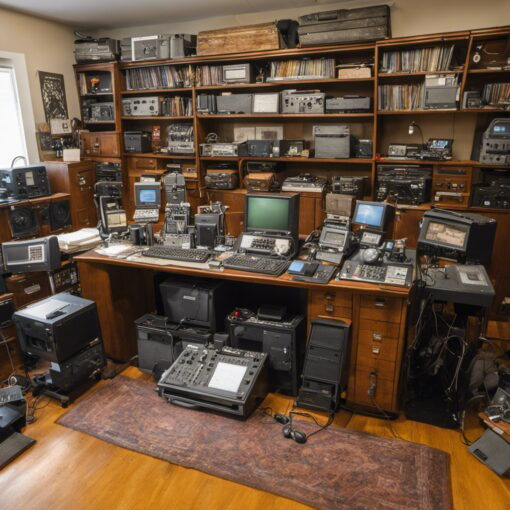Ham radio enthusiasts employ an array of specialized communication methods, and one of the critical tools in their linguistic arsenal is Q-codes. These are standardized sets of three-letter message encodings that originated in the early 20th century. While initially designed for Morse code communications, Q-codes have transcended their original purpose, becoming ubiquitous in various modes of amateur radio communication.


Due to their concise nature, Q-codes provide a quick and universally understood means to convey complex information with ease. They cover operational instructions, signal quality reports, and questions pertinent to the hobby. Whether inquiring about the frequency of operation or acknowledging receipt of a message, Q-codes streamline the exchange of information, making them a cornerstone in the fabric of the ham radio lexicon.
Key Takeaways
- Q-codes are essential tools for efficient communication in amateur radio.
- These codes are universally recognized, facilitating global interaction among operators.
- Ham radio transmissions rely on Q-codes for conveying complex information succinctly.
Understanding Q-Codes


Q-Codes are a set of abbreviations used in amateur radio communications to exchange information efficiently. They originated from telegraphy codes and have become an integral part of ham radio lingo, facilitating clear and rapid communication.
Purpose and Function
Q-Codes serve as a standardized set of shorthand signals that help radio operators to convey messages concisely. They are used to ask questions, provide answers, and inform other operators about specific details of radio communication and operation. These codes are universally recognized, ensuring that even when language barriers exist, communication remains possible and effective.
Common Q-Code List
Here is a list of some common Q-Codes used in ham radio:
- QTH: Provides or requests the station’s location.
- QRL: Inquires if a frequency is busy.
- QRM: Indicates interference from other signals.
- QRN: Indicates interference from static or atmospheric noise.
- QRO: Suggests increasing transmit power.
- QRP: Indicates reducing transmit power or refers to low-power operation.
- QRS: Requests to send more slowly.
- QRT: Signals to cease transmission or operation.
- QRU: Inquires if there is anything for the contacting station.
- QRV: Indicates readiness to receive messages.
- QRZ: Asks for the identification of the station being called.
- QSB: Reports fading signal strength.
- QSL: Confirms receipt of a message or can refer to the exchange of confirmation cards.
- QSO: Describes a completed contact or conversation.
- QSY: Requests to change frequency.
- QRQ: Requests to send faster.
- QRK: Queries the readability of the signals.
- QSA: Questions the strength of signals.
- QSB: Reports variations in signal strength.
- QSD: Asks if your keying is defective.
- QSK: Informs that the operator can hear during transmissions.
- QTC: Informs about the number of messages to be sent.
For operators, understanding and using Q-Codes is an essential skill, as they are commonly used in the language of ham radio and can streamline the process of establishing and maintaining contact with others in the amateur radio community.
Operational Use of Q-Codes


Q-Codes are sets of abbreviated signals used extensively in ham radio to streamline communication, clarify messages, and address technical issues during operations. These codes provide a universal shorthand across different languages and regions, enhancing efficiency and understanding.
Basic QSO Procedures
In the realm of ham radio, QSO refers to a conversation between two operators. The use of Q-Codes simplifies the initiation and management of these communications. For example, QRZ is employed when an operator asks “Who is calling me?” When an acknowledgment is required, QSL is the concise way to request or confirm receipt of a message. After establishing contact, QTH conveys the station’s location, and QRS, signaling “send more slowly,” may be used to accommodate the receiving party’s proficiency or reception clarity.
Handling Interference and Signal Issues
Interference is a common challenge in any radio operation. Operators may employ QRN to denote static or natural interference and QRM for man-made interference. When experiencing signal fading or a weak transmission, one can use QSB to indicate the situation. If the interference makes continued communication untenable, QRT, which stands for “stop sending,” may be necessary. On the contrary, if the operator is prepared to handle the received messages, QRV, meaning “ready” is used.
Amplifying Signal Information
To convey changes or needs related to signal strength and clarity, operators utilize Q-Codes like QRO and QRP to adjust the power of the transmitter up or down, respectively. When it comes to the exactness of frequency, QRU hints there’s nothing more to be sent on the current frequency, while QSY suggests changing to another frequency. If an operator needs to communicate faster, they could use QRQ, or conversely, QRS for a slower pace. For clarity in code, QSD points out that the keying is bad, prompting adjustments to improve the tone and intelligibility.
In integrating these Q-Codes into operations, radio enthusiasts facilitate prompt and effective communication, navigate technical challenges, and maintain the high standard of interaction that is key to successful amateur radio engagement.
Technical Aspects
In the realm of ham radio, the technical aspects encompass crucial components like frequency utilization and power management. Operators need to navigate these elements effectively to maintain clear and efficient communications.
Frequency and Power Regulations
Frequency management in ham radio is essential for avoiding interference and complying with international guidelines set by the International Telecommunication Union (ITU). Ham operators use Q-codes such as QRG to inquire about an exact frequency or to inform others of their frequency. For instance, a response to “QRG?” could be “My frequency is 7.125 MHz.”
Power levels, critical for both compliance and effective transmission, are indicated by codes like QRO for high power and QRP for low power operation. QSA and QSB are used to query and describe the strength and clarity of signals, ensuring adjustments can be made to optimize transmission quality.
| Q-Code | Description | Relevant in context to |
|---|---|---|
| QRG | Exact frequency | How to determine or report frequency |
| QRO | Increase power | When higher transmission power is needed |
| QRP | Decrease power | Low power operation for skill or regulation compliance |
| QSA | Signal strength | Communicating clear reception quality |
| QSB | Signal fading | Identifying fading signals |
Equipment Settings and Adjustments
Proper equipment settings ensure adherence to regulations and enhance the service quality of ham radio operations. Ham radio enthusiasts use Q-codes to facilitate efficient communication about equipment adjustments. QRK relates to the readability of signals, while QRN signals the presence of static or noise. Operators may need to adjust the kHz or MHz settings on their equipment to reduce interference and improve clarity.
It is also essential for hams to confirm whether their keying is defective by using the QSD code, or to announce they are ready to receive with QSK. Adjusting these settings is crucial for maintaining a reliable service that hams provide during emergencies or as part of their hobby.
Communicating frequency changes is done using QRG, which informs others about the current operating frequency. Moreover, QRH indicates frequency variability, which can be critical when precision is necessary or when troubleshooting equipment performance. These technical aspects are the bedrock of effective and responsible ham radio use.
Q-Codes in the International Context
Q-Codes have been adopted as a universally recognized set of abbreviations to streamline communication across the international ham radio community. They provide a standardized method for exchanging information, even when common language is not shared between operators.
ITU Standardization
The International Telecommunication Union (ITU) plays a critical role in the standardization of Q-Codes across the spectrum of international ham radio operations. Originally derived from telegrams, Q-Codes like QRA (the name of your station), QSL (acknowledge receipt), QSO (a conversation), QSY (changing frequency), and QTH (your location), are standardized through ITU’s regulations. This ensures a uniform understanding regardless of the operator’s native language.
Global Ham Radio Etiquette
Usage of Q-Codes forms a fundamental part of global ham radio etiquette. They serve as a linguistic bridge enabling operators to charge through language barriers with concise statements. For example, a QSL card is often exchanged as a confirmation of a QSO, representing a tangible acknowledgment of the radio communication. The QSY indicates a frequency change, an action central to maintaining order on the airwaves. Across continents, ham radio enthusiasts utilize these standardized codes to convey clear, universally understood messages.





